The kind folks at the local Fox news affiliate here in DC stopped by and did a little report on the Fall Bonsai Exhibit. I tried to embed the video in this post but was unable to figure out how. You’ll have to click here to watch it. Hope you enjoy it.
Tag Archives: Autumn
Falling into Winter, part 2
As the trees on exhibit move past their peak fall color we replace them with trees that are just beginning to shine. Here are the new additions as well as a few from the first post that look better than they first did.
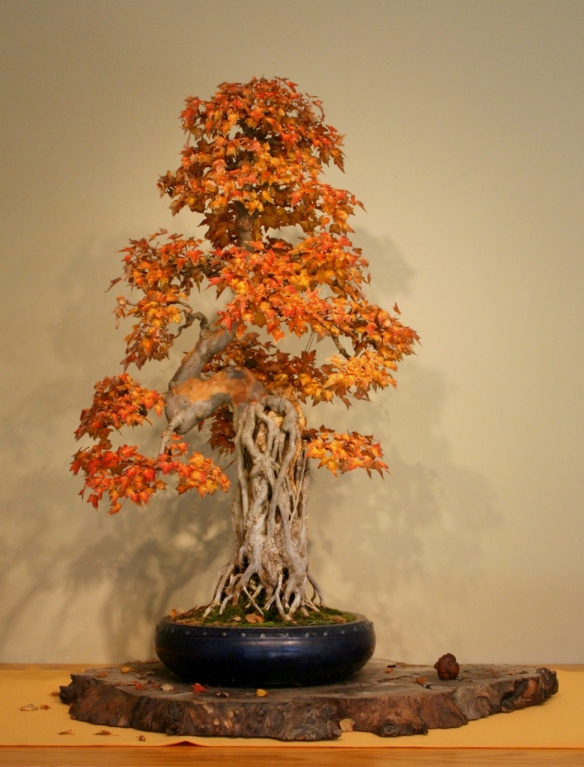 Trident Maple, Donated by Stanley Chin, Age Unknown
Trident Maple, Donated by Stanley Chin, Age Unknown
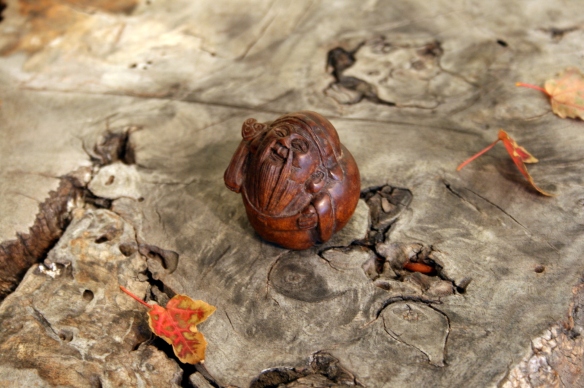 Closeup of netsuke
Closeup of netsuke
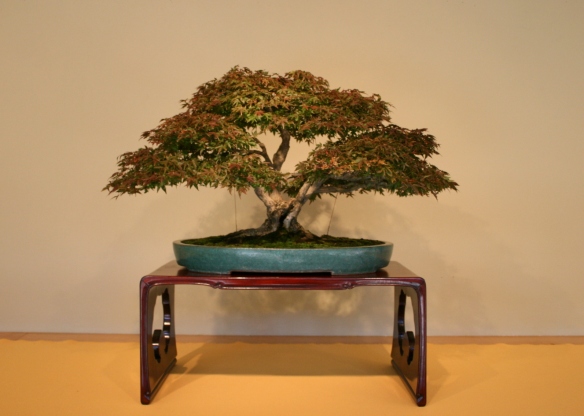 Japanese Maple, Donated by Shintaro Abe, In training since 1946.
Japanese Maple, Donated by Shintaro Abe, In training since 1946.
Red Maple, Acer rubrum var. Drummondii, Donated by Vaughn Banting, In training since 1974.
Cedar Elm, Ulmus crassifolia, Donated by Arch Hawkins, In training since 1981.
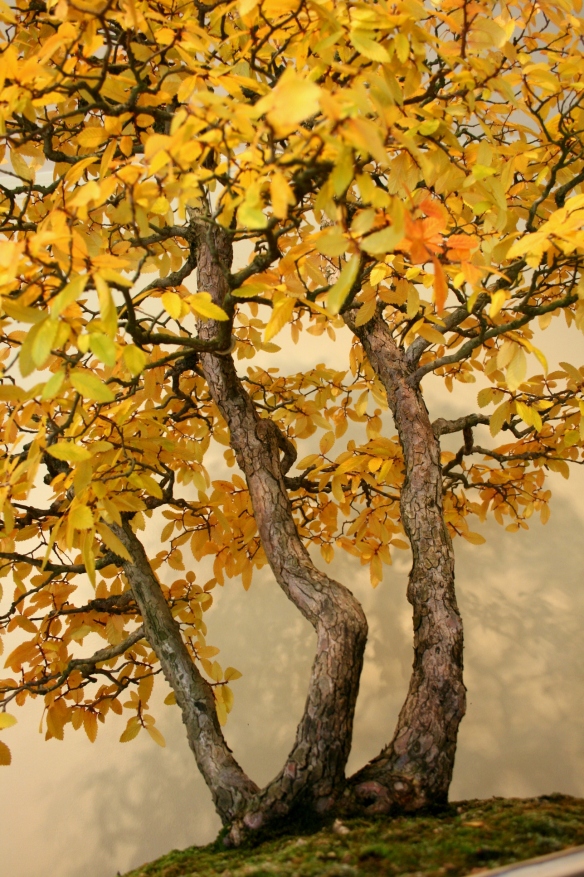 Close-up of trunks and branch structure.
Close-up of trunks and branch structure.
 Bald Cypress, Donated by Vaughn Banting, In training since 1972.
Bald Cypress, Donated by Vaughn Banting, In training since 1972.
Ginkgo biloba, Donated by Masayuki Fujio, In training since 1896.
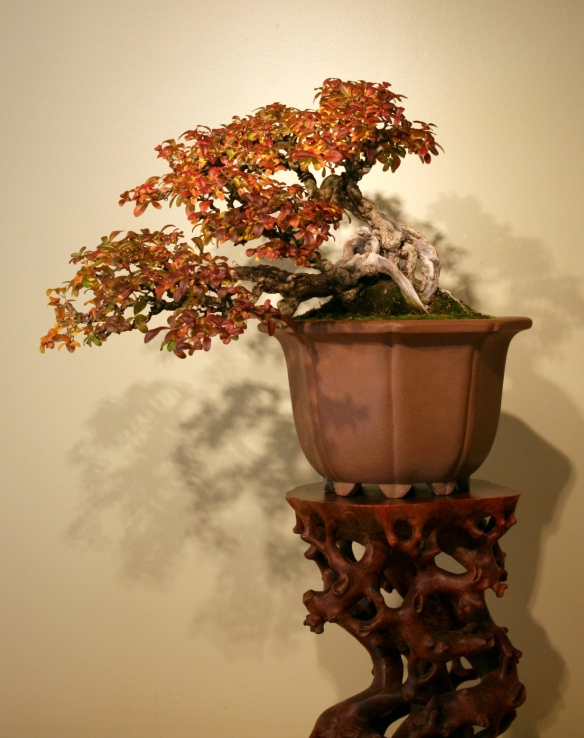 Japanese Privet, Ligustrum obtusifolium, Donated by Seiko Koizumi, In training since 1968.
Japanese Privet, Ligustrum obtusifolium, Donated by Seiko Koizumi, In training since 1968.
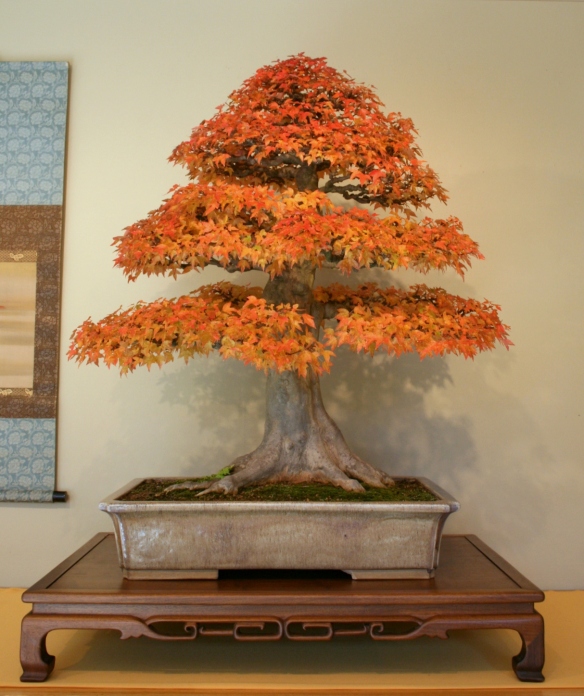 Trident Maple, Donated by Ted Guyer, In training since 1975.
Trident Maple, Donated by Ted Guyer, In training since 1975.
Japanese Maple, Donated by Ryutaro Azuma, In training since 1906.
Liquidambar, Donated by Vaughn Banting, In training since 1975. The photo doesn’t do the tree justice regarding its actual color. Its almost a neon red. When you see it in person the tree seems like it is glowing.
Golden Larch, Pseudolarix amabilis, Donated by Shu-ling Lui, In training since 1971.
Thanks for reading. I will be posting the final installment of this years fall exhibit next week. This coming weekend will be your last opportunity to see this special Fall Exhibit, so if you live in or near DC stop by the Museum and enjoy the trees before all the leaves are gone.
Happy Halloween 2013
Falling into Winter, Autumn Bonsai Exhibition 2013
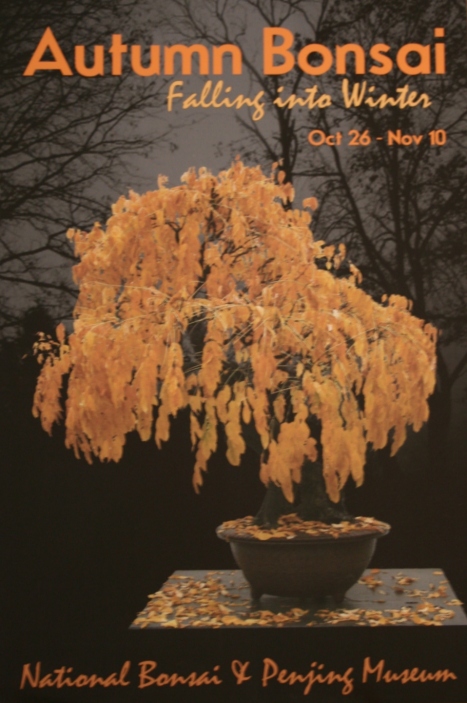 Thankfully things in Washington got sorted out in time for our annual fall exhibition. The exhibit runs from October 26 – November 10. Trees will be rotated in and out as they come into peak color and I will post addition pictures as we change them.
Thankfully things in Washington got sorted out in time for our annual fall exhibition. The exhibit runs from October 26 – November 10. Trees will be rotated in and out as they come into peak color and I will post addition pictures as we change them.
 Bradford Pear, Pyrus calleryana ‘Bradford’, In training since 1976, Styled by the first curator Bob Drechsler.
Bradford Pear, Pyrus calleryana ‘Bradford’, In training since 1976, Styled by the first curator Bob Drechsler.
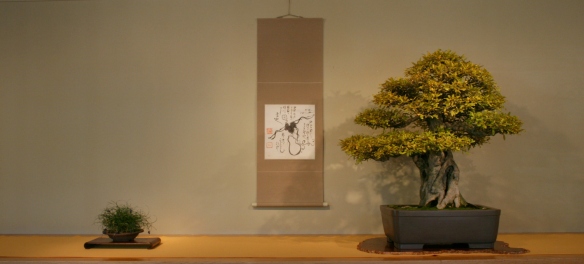 Three point display: Pomegranate bonsai, scroll with gourd and calligraphy, and contorted mondo grass.
Three point display: Pomegranate bonsai, scroll with gourd and calligraphy, and contorted mondo grass.
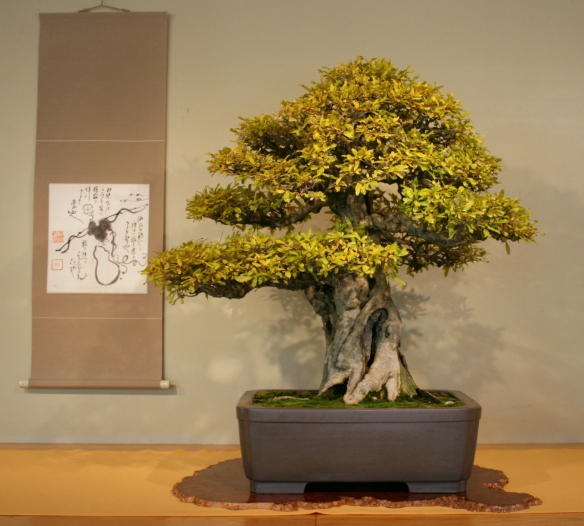 Pomegranate, Punica granatum, In training since 1963, Donated by Alice Naka.
Pomegranate, Punica granatum, In training since 1963, Donated by Alice Naka.
 Contorted mondo grass, Ophiopogon chingii.
Contorted mondo grass, Ophiopogon chingii.
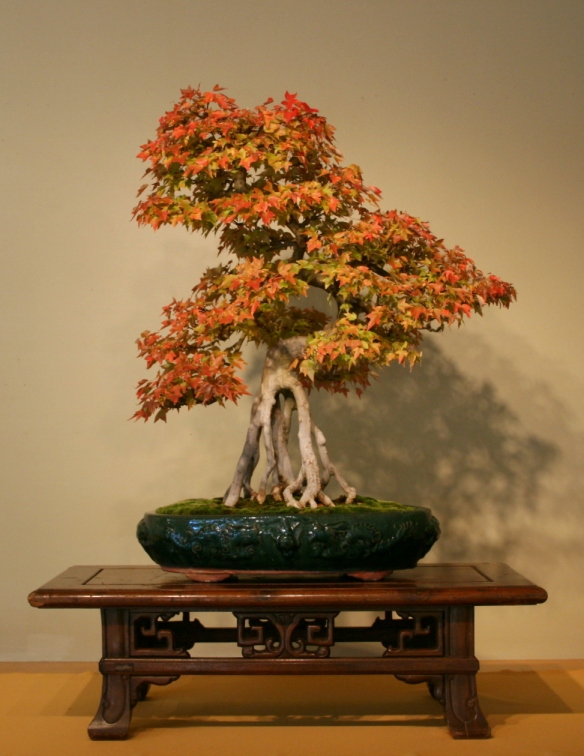 Trident Maple, Acer buergerianum, Age unknown, Donated by Stanley Chin.
Trident Maple, Acer buergerianum, Age unknown, Donated by Stanley Chin.
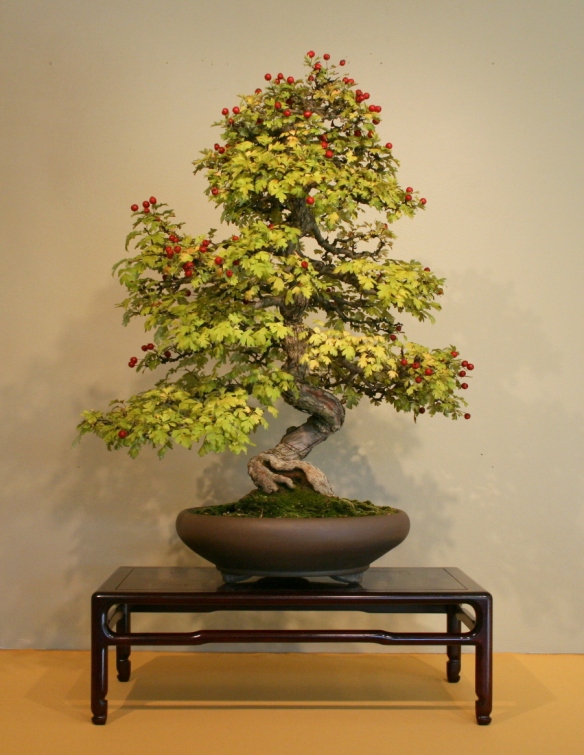 English Hawthorn, Crataegus oxycantha, In training since 1955, Donated by Bertra Bruenner.
English Hawthorn, Crataegus oxycantha, In training since 1955, Donated by Bertra Bruenner.
 Three point display: Crabapple bonsai, scroll of Mt. Fuji and rising sun, and Japanese forest grass accent.
Three point display: Crabapple bonsai, scroll of Mt. Fuji and rising sun, and Japanese forest grass accent.
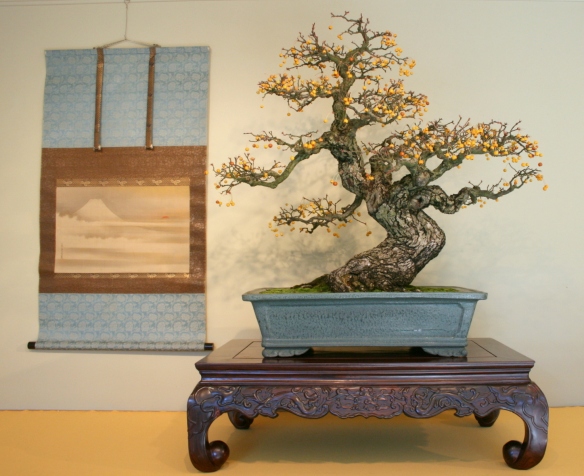 Toringo Crabapple, Malus seiboldii ‘Toringo’, In training since 1905, Donated by Shyuichi Ueda.
Toringo Crabapple, Malus seiboldii ‘Toringo’, In training since 1905, Donated by Shyuichi Ueda.
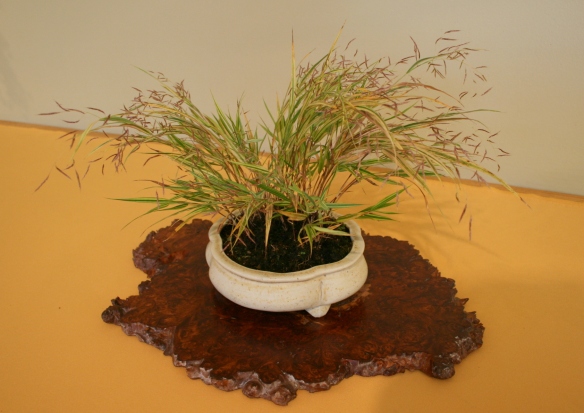 Japanese forest grass, Hakonechloa macra.
Japanese forest grass, Hakonechloa macra.
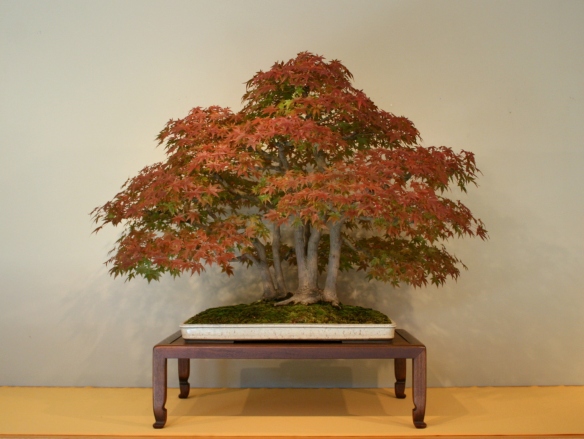 Japanese Maple, Acer palmatum, In training since 1906, Donated by Ryutaro Azuma.
Japanese Maple, Acer palmatum, In training since 1906, Donated by Ryutaro Azuma.
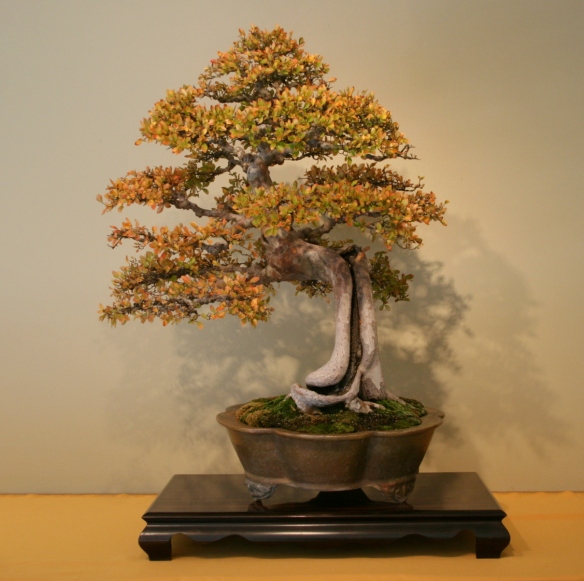 Chinese Elm, Ulmus parvifolia, In training since 1906, Donated by Yee-sun Wu.
Chinese Elm, Ulmus parvifolia, In training since 1906, Donated by Yee-sun Wu.
 Three point display: Gingko bonsai, viewing stone, and sedum.
Three point display: Gingko bonsai, viewing stone, and sedum.
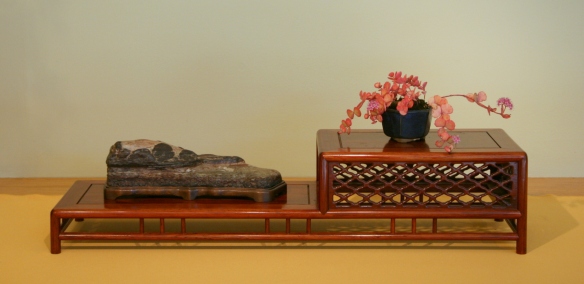 Indian Blanket Stone donated by Melba Tucker, and sedum.
Indian Blanket Stone donated by Melba Tucker, and sedum.
 Three point display: Sweet Gum bonsai, scroll with bird and nandina, and Japanese bloodgrass.
Three point display: Sweet Gum bonsai, scroll with bird and nandina, and Japanese bloodgrass.
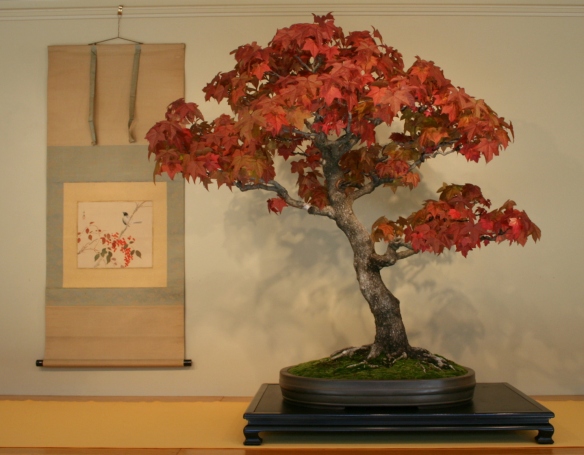 Sweet Gum, Liquidambar styraciflua, In training since 1975, Donated by Vaugh Banting.
Sweet Gum, Liquidambar styraciflua, In training since 1975, Donated by Vaugh Banting.
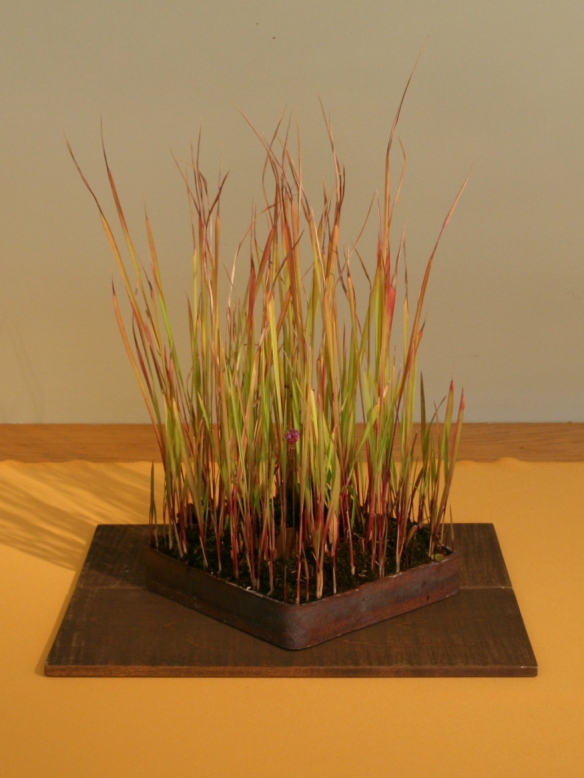 Japanese blood grass, Imperata cylindrica, pot by Sharon Edwards-Russell.
Japanese blood grass, Imperata cylindrica, pot by Sharon Edwards-Russell.
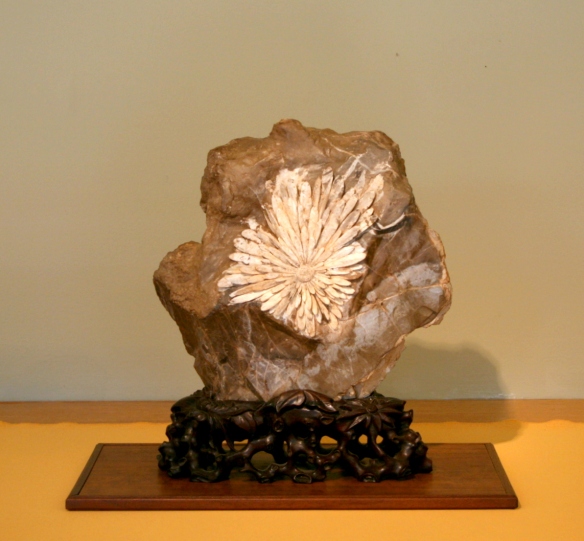 Chrysanthemum Stone, Donated by Kemin Hu.
Chrysanthemum Stone, Donated by Kemin Hu.
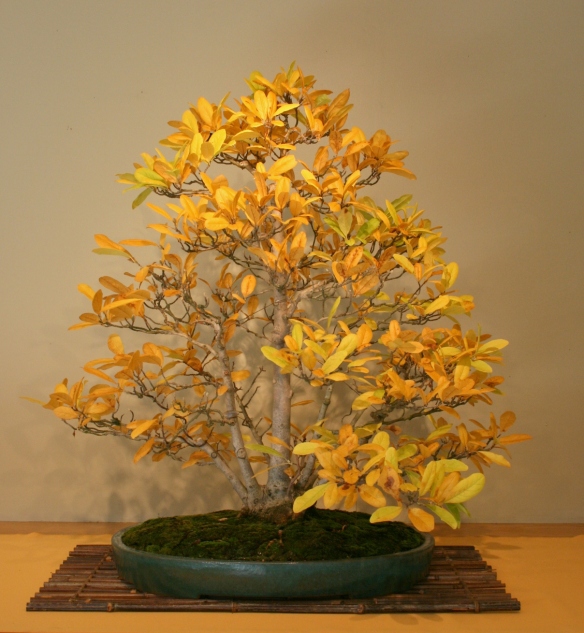 Star magnolia, Magnolia stellata, In training since 1986 , Donated by Kazuo Moriyama.
Star magnolia, Magnolia stellata, In training since 1986 , Donated by Kazuo Moriyama.
Autumn Tokonoma Display
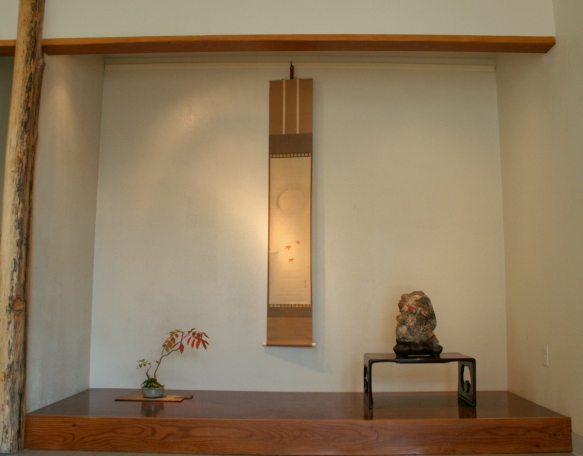 The first tokonoma display of fall is traditional three point display made up of a stone, a scroll, and an accent plant. A typical three point display contains a primary element that holds the visual weight of the space. This is typically a bonsai or viewing stone but can also be a scroll. The second element has less visual weight and can also be a bonsai, stone, or scroll.
The first tokonoma display of fall is traditional three point display made up of a stone, a scroll, and an accent plant. A typical three point display contains a primary element that holds the visual weight of the space. This is typically a bonsai or viewing stone but can also be a scroll. The second element has less visual weight and can also be a bonsai, stone, or scroll.
The third component can be an accent plant, small stone or some decorative art object like an okimono.
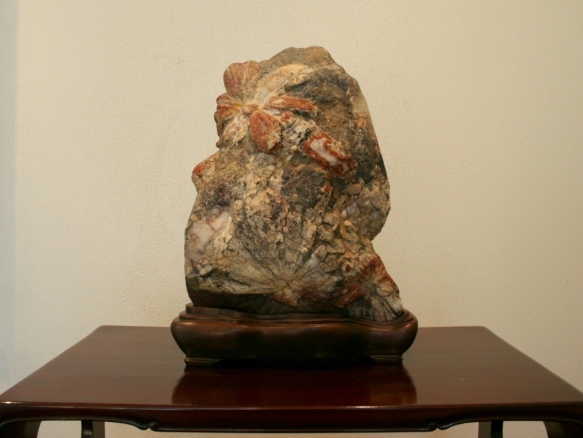 The primary element in this display is a Chrysanthemum stone from Sado Island donated by Ralph Johnson.
The primary element in this display is a Chrysanthemum stone from Sado Island donated by Ralph Johnson.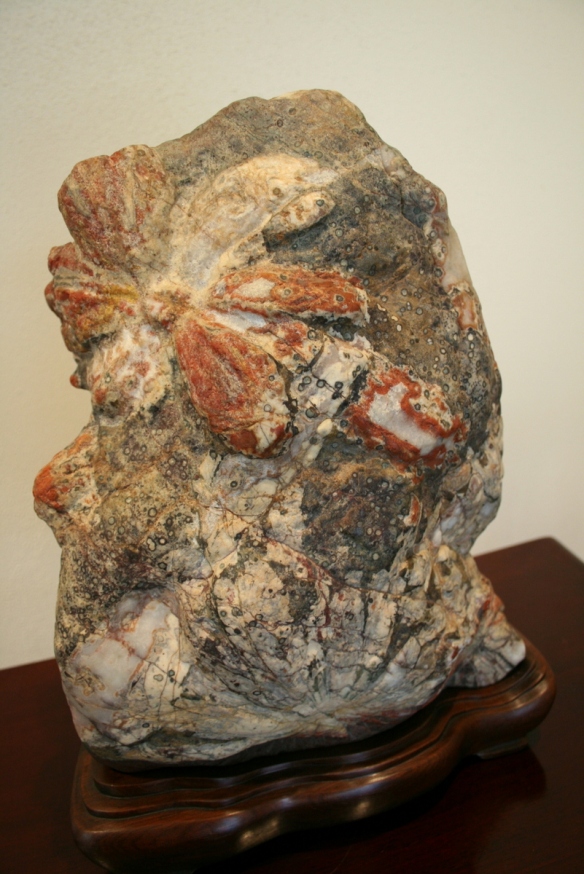 This close-up view of the stone shows the various mineral deposits within the stones matrix.
This close-up view of the stone shows the various mineral deposits within the stones matrix.
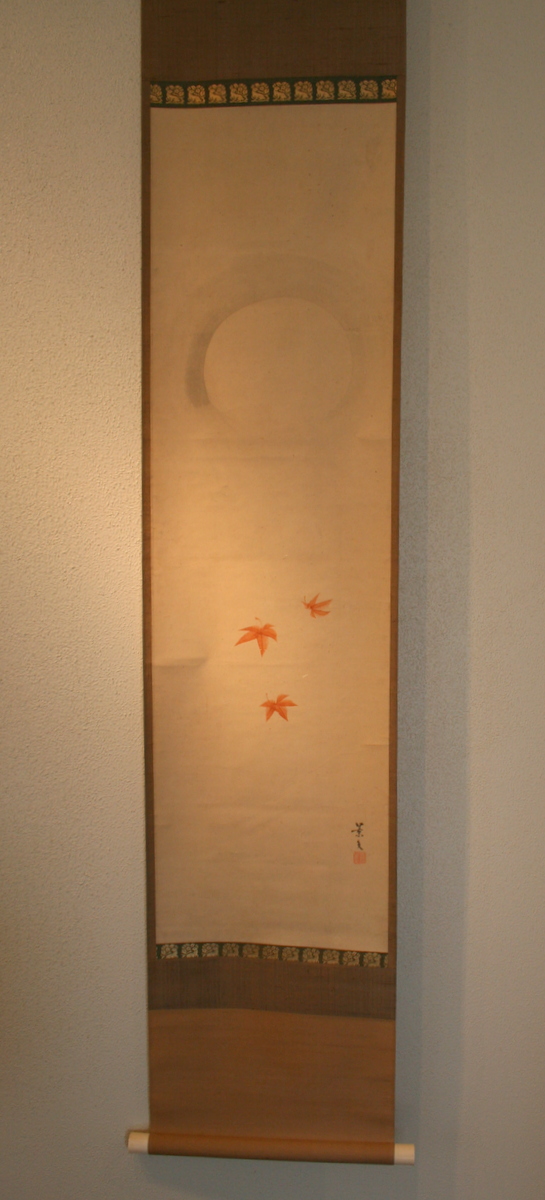 The second element is a scroll depicting a moon with falling maple leaves, possibly from the tree in the summer display. This scroll was painted by Matsumura Keibun 景文 松村 (1779 – 1843) “He was a leading figure in the Shijo school established by his half-brother, Matsumura Goshun (1752-1811). Their father, a fourth-generation official of the Kyoto gold mint, died when Keibun was two years old, making it likely that he would follow Goshun, 27 years his senior, into an artistic career. Keibun mastered the techniques of painting taught at Goshun’s studio at Shijo-Sakaimachi in Kyoto. He studied the work of Maruyama Okyo (1733–1795), whose blend of realism and decorative beauty exerted a major influence on him. Keibun’s numerous sketchbooks reveal his lifelong adherence to Okyo’s dictum to draw from nature. Additionally, he was familiar with Chinese literati painting (Bunjinga) and art theories of the Ming (1368–1644) and Qing (1644–1911) periods. In his later years he associated with Koishi Genzui (1793–1865), a leading figure of Confucian literati circles in Kyoto. In 1797 Keibun’s work was chosen for exhibition by the leading literati scholar and painter, Minagawa Kien (1734–1807) who from 1792 sponsored twice-yearly exhibitions of new works of painting. By 1801 his designs were being included with those of Goshun and other Kyoto artists in woodblock-printed picture-books (ehon). After Goshun’s death in 1811 Keibun shared the leadership of the Shijo school with fellow-pupil Okamoto Toyohiko (1773-1845), and the two became the most popular painters in Kyoto. Keibun was particularly noted for his bird-and-flower (kacho) compositions.(MyJapanesehanga.com)
The second element is a scroll depicting a moon with falling maple leaves, possibly from the tree in the summer display. This scroll was painted by Matsumura Keibun 景文 松村 (1779 – 1843) “He was a leading figure in the Shijo school established by his half-brother, Matsumura Goshun (1752-1811). Their father, a fourth-generation official of the Kyoto gold mint, died when Keibun was two years old, making it likely that he would follow Goshun, 27 years his senior, into an artistic career. Keibun mastered the techniques of painting taught at Goshun’s studio at Shijo-Sakaimachi in Kyoto. He studied the work of Maruyama Okyo (1733–1795), whose blend of realism and decorative beauty exerted a major influence on him. Keibun’s numerous sketchbooks reveal his lifelong adherence to Okyo’s dictum to draw from nature. Additionally, he was familiar with Chinese literati painting (Bunjinga) and art theories of the Ming (1368–1644) and Qing (1644–1911) periods. In his later years he associated with Koishi Genzui (1793–1865), a leading figure of Confucian literati circles in Kyoto. In 1797 Keibun’s work was chosen for exhibition by the leading literati scholar and painter, Minagawa Kien (1734–1807) who from 1792 sponsored twice-yearly exhibitions of new works of painting. By 1801 his designs were being included with those of Goshun and other Kyoto artists in woodblock-printed picture-books (ehon). After Goshun’s death in 1811 Keibun shared the leadership of the Shijo school with fellow-pupil Okamoto Toyohiko (1773-1845), and the two became the most popular painters in Kyoto. Keibun was particularly noted for his bird-and-flower (kacho) compositions.(MyJapanesehanga.com)
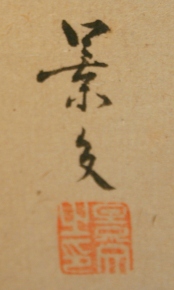 Signature and chop of Matsumura Keibun.
Signature and chop of Matsumura Keibun.
 The third and last component is an accent planting of Sumac, Rhus copallium, in fall color with fern, Selaginella sp.
The third and last component is an accent planting of Sumac, Rhus copallium, in fall color with fern, Selaginella sp.
This display was only installed for a few days as the Sumac quickly dropped its leaves. Fall is a wonderful time to create displays as trees and plants are changing color on a daily basis.
On that note, our annual Fall bonsai exhibit opens tomorrow, Saturday October 20th and continues through November 4th.
Please subscribe to this blog in order to receive updates of new posts, to support the N.B.P.M., and to help me know how many people are reading. Thanks!

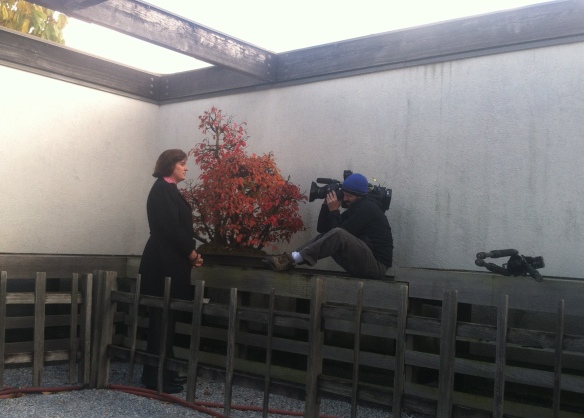
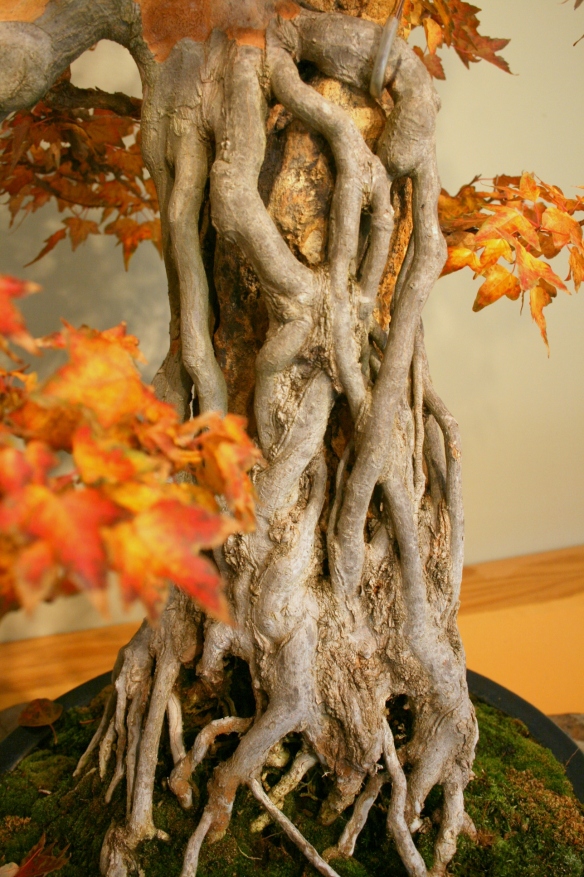
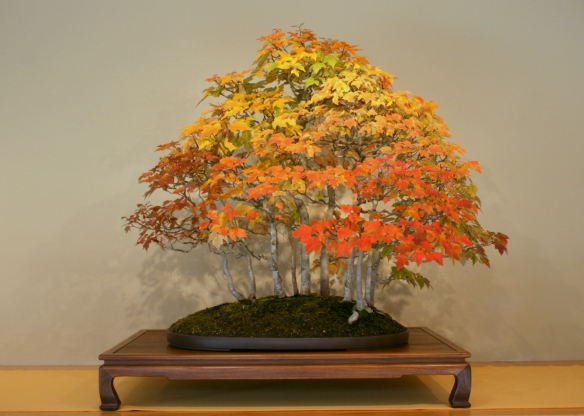
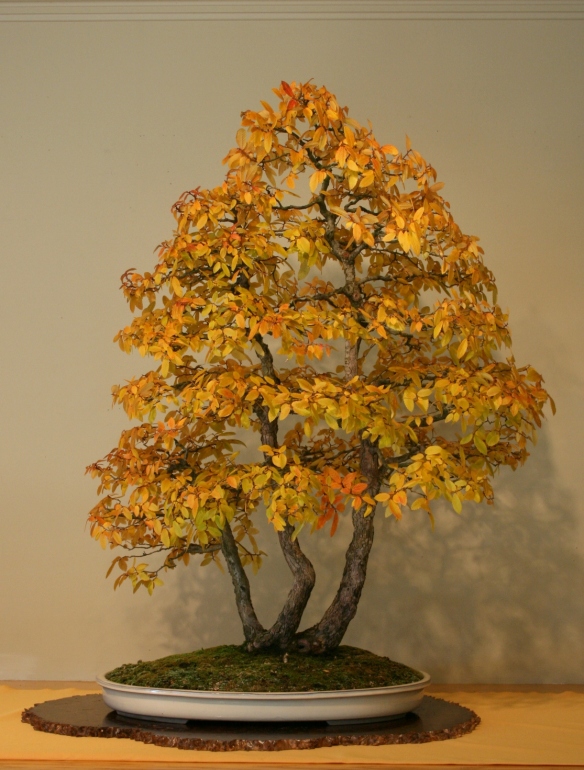
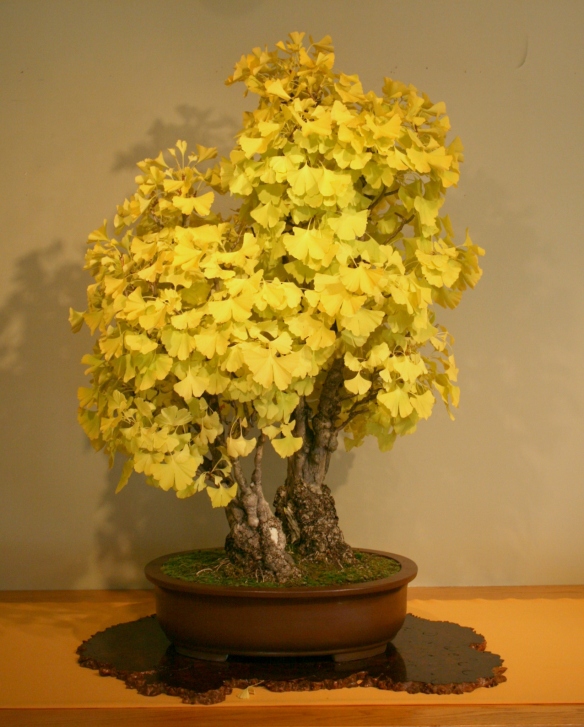
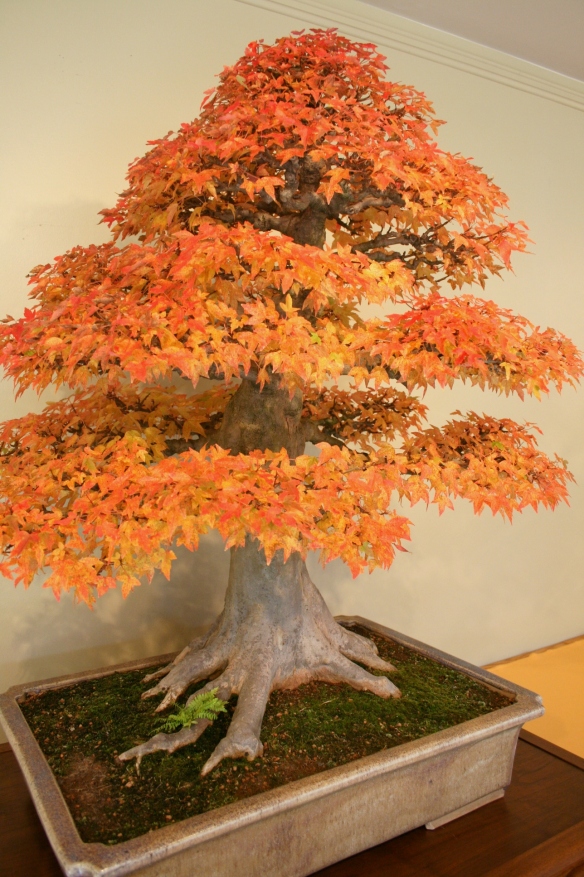
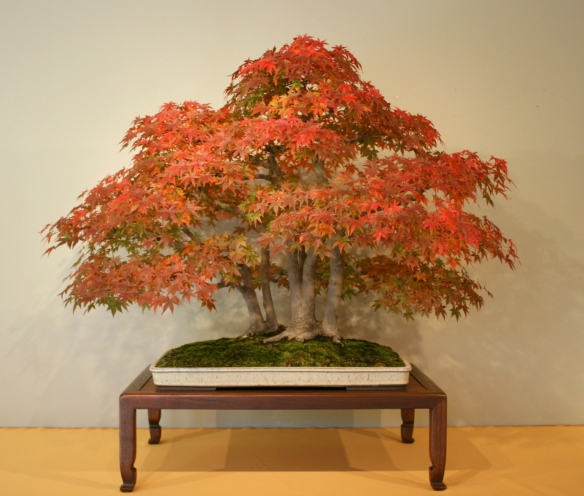
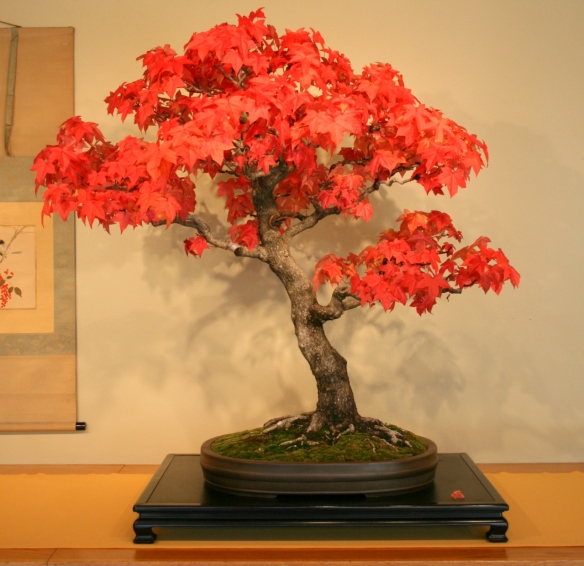

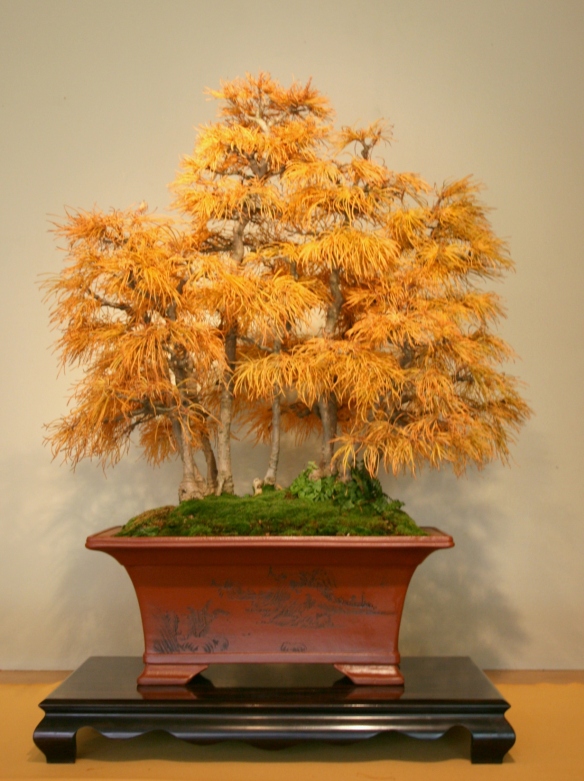





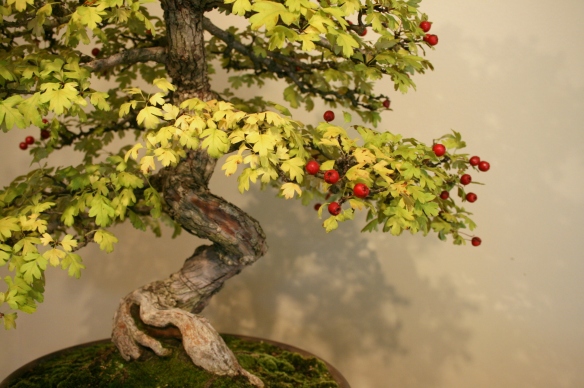

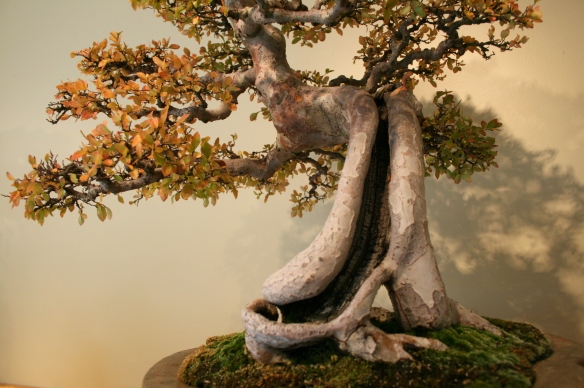
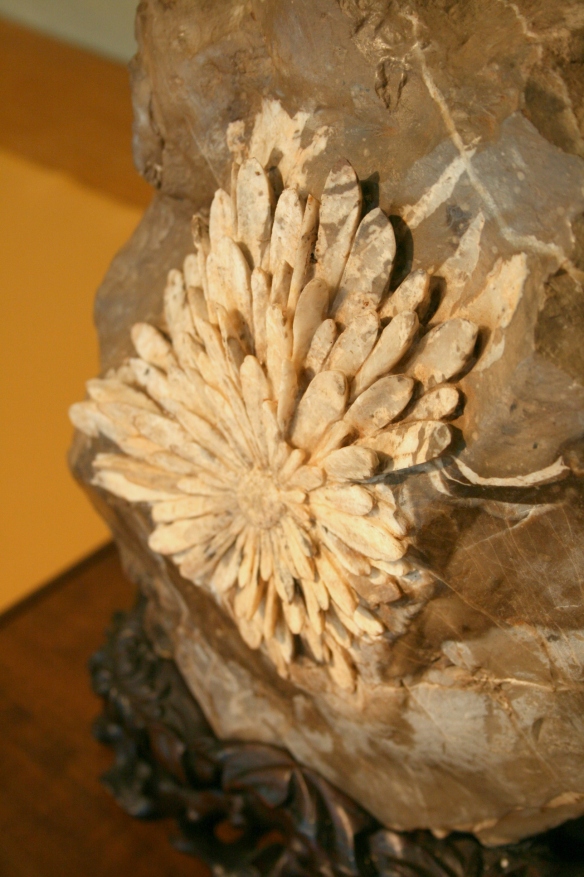
You must be logged in to post a comment.